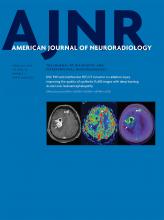Index by author
Xiang, H.
- LetterYou have accessThe “Bovine Aortic Arch”: Time to Rethink the True Origin of the Term?L.J. Ridley, J. Han and H. XiangAmerican Journal of Neuroradiology February 2019, 40 (2) E7-E8; DOI: https://doi.org/10.3174/ajnr.A5924
Xie, F.
- Adult BrainYou have accessAlterations in Brain Metabolites in Patients with Epilepsy with Impaired Consciousness: A Case-Control Study of Interictal Multivoxel 1H-MRS FindingsZ. Tan, X. Long, F. Tian, L. Huang, F. Xie and S. LiAmerican Journal of Neuroradiology February 2019, 40 (2) 245-252; DOI: https://doi.org/10.3174/ajnr.A5944
Xing, F.
- EDITOR'S CHOICEHead & NeckOpen AccessTreatment Response Prediction of Nasopharyngeal Carcinoma Based on Histogram Analysis of Diffusional Kurtosis ImagingN. Tu, Y. Zhong, X. Wang, F. Xing, L. Chen and G. WuAmerican Journal of Neuroradiology February 2019, 40 (2) 326-333; DOI: https://doi.org/10.3174/ajnr.A5925
Thirty-six patients with an initial diagnosis of locoregionally advanced nasopharyngeal carcinoma and diffusional kurtosis imaging acquisitions before and after neoadjuvant chemotherapy were enrolled. Patients were divided into respond-versus-nonrespond groups after neoadjuvant chemotherapy and residual-versus-nonresidual groups after radiation therapy. Receiver operating characteristic analysis indicated that setting pre-D50th = 0.875 x 10-3 mm2/s as the cutoff value could result in optimal diagnostic performance for neoadjuvant chemotherapy response prediction (area under the curve = 0.814, sensitivity = 0.70, specificity = 0.92), while the post-K90th = 1.035 (area under the curve = 0.829, sensitivity = 0.78, specificity = 0.72) was optimal for radiation therapy response prediction. Histogram analysis of diffusional kurtosis imaging may potentially predict the neoadjuvant chemotherapy and short-term radiation therapy response in locoregionally advanced nasopharyngeal carcinoma.








